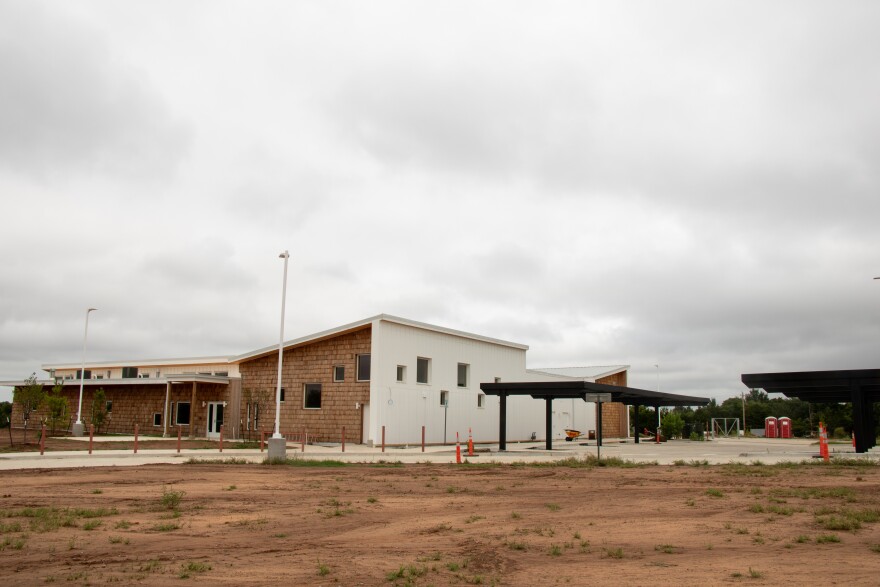Positioned near hills and a dense line of trees, the Caddo Nation's new child care center in Hinton won't just be shaping young minds. Plans for the site include generating enough solar energy to power the building through 217 rooftop and carport panels.
Although the center will still be plugged into the electric grid and receive a utility bill, officials with the project say the charge should be significantly lower than without solar. The installation is among the first developed by Saku, a joint venture between the Caddo Nation and solar company EightTwenty.
" Saku is the Caddo word for sun," Zackeree Kelin, vice chairman of the Caddo Nation Economic Development Authority, said. "And the goal of it was to power tribes' future with solar."
Kelin said by reducing energy costs with solar power, the Caddo Nation can allocate more dollars to other operations. The money is intended to bolster tribal citizen services.

Maximizing solar incentives
Another reason for the collaboration with EightTwenty, Kelin said, is rooted in federal tax incentives, some of which were expanded in recent years.
" We formed a relationship with them primarily because of, in part, the tax credits in Indian country were one of the most underutilized tax credits there are," he said.
Under the 2022 Inflation Reduction Act, many solar projects can receive a 30% tax credit to lessen the total cost of installation. The Caddo Nation was able to stack the incentives with smaller credits for tribal lands and products made in the U.S. The project got up-front funding from EightTwenty's sister company, Brightwell, which offsets project costs with the federal incentives and investor matching.
" Whether it's economic development or the provision of tribal services, reducing the spend on energy is something that Indian Country is very much in need of, is being very responsive to, and trying to control more of their energy resources is a big deal in Indian Country," Kelin said.
Now, the federal credits intended to boost American solar power are expiring years earlier than originally planned. The One Big Beautiful Bill, which became law earlier this summer, sunsets federal incentives to install solar and wind projects.
Homeowners have until midnight on Dec. 31 to pay, at least partially, for residential solar projects to get the 30% credit. Commercial installations have access to the incentive through 2027.
The U.S. Environmental Protection Agency has also ended a solar program for disadvantaged communities. Solar For All was set to allocate $7 billion to develop residential solar in states including Oklahoma. The Caddo Nation was a subrecipient of one of the grants, Kelin said.
The actions are part of a string of restrictions on renewables in the U.S. and executive orders from President Donald Trump aimed at expanding the oil and gas industry. Oklahoma lawmakers, including Republican U.S. Senators James Lankford and Markwayne Mullin, have supported Trump's energy efforts.
What's behind the federal withdrawal from renewable energy?
The U.S. has a solar tax credit history dating back to the late 1970s, though the current version of the incentive has been around since the 2000s. The most recent solar credit expansion was part of a broad policy package designed to lower greenhouse gas emissions and combat climate change.
Reshuffling federal energy policy isn't unique to this administration. Cory Baitz, vice president of design for EightTwenty, said uncertainty about tax credits is embedded in the solar business.
" For the folks that have been in the industry for a long time, this is sort of the norm, and it's all about just riding the waves and seeing what comes next," he said.
Large-scale solar is touted as the cheapest form of energy generation in some financial reports. It also accounts for half of the nation's projected new electric generating capacity, data from the U.S. Energy Information Administration show.
But misinformation surrounding renewable energy persists, delaying or halting projects in some communities. Part of the distrust could be due to a misunderstanding of the electric grid, said Kylah McNabb, executive director for the Oklahoma Renewable Energy Council and owner of consulting firm Vesta Strategic Solutions.
"Folks that I've worked with across the nation, past and currently, have found it very interesting that we're finding ourselves in the same position we were about 15 years ago, with a need for basic education on where electrons come from," she said.
All-of-the-above energy strategy
The diversification of energy is needed to meet electricity demands, McNabb said.
"The system's larger than one particular set," she said. "And no energy source is infallible, as we saw with winter storm Uri. I think that was the biggest indicator, too, that I think we all realize that we need a variety of different sources and to not put your eggs all in one basket."
In Hinton, electric generation will be on display around the Caddo Nation's child care center. Swirling wind turbines on the horizon behind the building and Caddo County's oil and gas wells contribute to the state's energy profile.
Baitz said the diversity of energy aligns with the use of the building, and solar might become a fixture in the children's lives.
" We're very excited that we could do this for a child care center," he said. "I mean, you think about not only the benefit financially that the center would see operationally, but the exposure of solar to the kids that are going to come here, and it's transformative in the way where those kids, when they see it on an everyday basis, solar becomes normative."
At the time of publication, construction on the solar panels was set to begin in mid-September, and the child care center was scheduled to open in January.
Copyright 2025 KGOU







